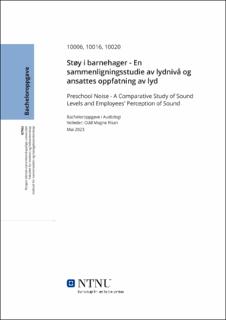| dc.contributor.advisor | Risan, Odd Magne | |
| dc.contributor.author | Mork, Edgar | |
| dc.contributor.author | Schjerven, Niklas Gamst | |
| dc.contributor.author | Rutgersen, Mathias | |
| dc.date.accessioned | 2023-06-23T17:19:31Z | |
| dc.date.available | 2023-06-23T17:19:31Z | |
| dc.date.issued | 2023 | |
| dc.identifier | no.ntnu:inspera:146310594:68374596 | |
| dc.identifier.uri | https://hdl.handle.net/11250/3072961 | |
| dc.description.abstract | Bakgrunn: Et støyende arbeidsmiljø er en risiko for ansatte på arbeidsplassen, og dersom dette ikke følges opp kan det medføre både fysiske og psykiske helseproblemer for den enkelte.
Formål: Formålet med dette prosjektet var å undersøke samsvar mellom objektive lydmålinger fra ulike barnehager og barnehageansattes subjektive oppfatning av lydnivåene. Formålet videre var om det burde iverksettes tiltak for å begrense konsekvensene av støyen.
Metode: Studien ble gjennomført på barnehager i Trondheim. To kvantitative metoder ble brukt, derav syv lydmålinger og en spørreundersøkelse med 30 respondenter.
Resultat: Samtlige lydmålinger som ble gjort i studien var over arbeidstilsynets nedre terskelverdi for støynivå på arbeidsplassen, men under øvre grenseverdi. De fleste deltakerne var noe påvirket av støyen, og oppfattet at det var støyende lydmiljø i barnehagene. Få tiltak har blitt innført, med unntaket av støydempende materiale i vegger og tak.
Konklusjon: Prosjektet kom frem til at lydnivået i barnehager og de ansattes oppfatning hadde et generelt samsvar. Innførelsen av flere tiltak vil være aktuelt for å begrense støypåvirkning. Dette prosjektet legger til grunn for mer undergravende forskning om støy i norske barnehager. | |
| dc.description.abstract | Background: A noisy working environment poses a risk for employees in the workplace, and if not followed up, could lead to both physical and psychological health problems for the employees.
Objectives: The purpose of this study was to investigate the conformity between objective sound measurements from different preschools and the preschool employees' subjective perception of these sound levels. Furthermore, considerations were made whether additional measures should be taken to limit the consequences of noise exposure.
Methods: The study was carried out at three different preschools in Trondheim, Norway. Two quantitative methods were used, including seven sound measurements and a survey with 30 participants.
Results: The noise levels from all sound measurements were above the Norwegian Labor Inspection Authority’s lower threshold for noise levels in the workplace, but below the upper limit threshold. Most of the participants were somewhat bothered by the noise and perceived the preschool environment to be noisy. Few measures have been implemented, with the exception of noise-absorbing materials in the walls and ceilings.
Conclusions: The study concluded that noise levels in preschools were objectively loud, and that employees' subjective perception of these noise levels correlates to a certain degree. The introduction of several noise reducing measures were deemed relevant to limit the consequences of noise exposure. This study establishes the need for further and more elaborate research regarding noise exposure in preschool environments. | |
| dc.language | nob | |
| dc.publisher | NTNU | |
| dc.title | Støy i barnehager - En sammenligningsstudie av lydnivå og ansattes oppfatning av lyd | |
| dc.type | Bachelor thesis | |
